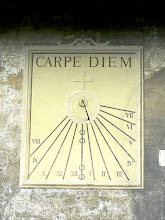JUPITER'S MOON IO, SHADOWS GANYMEDE


JUPITER MOON MOVIE: Four hundred years ago when Galileo discovered the moons of Jupiter, the satellites appeared in his primitive telescope as tiny, almost infinitesimal specks of light pirouetting around the giant planet. Their discovery transformed 17th century cosmology and made Galileo famous, but he never saw them as anything more than star-like pinpricks. The "Galilean satellites" were second-class citizens in the heirarchy of known worlds.
What would Galileo say now?
On August 16th, Philippine astrophotographer Christopher Go used
a modern 11-inch Celestron telescope to photograph Jupiter's moon Io
casting its shadow on Ganymede.
"I captured this rare event through a hole in the clouds," says Christopher Go.
"It was a lucky clearing!"
Io and Ganymede reveal themselves as fully-formed worlds with surface markings and a spherical shape.
Io's circular shadow cuts a dark swath across Ganymede, transforming that giant moon (it is larger than Mercury) into a succession of crescents rarely seen by observers.
Indeed, as far as we know, no telescope on Earth or space has ever photographed one of Jupiter's moons casting its circular shadow so clearly across another.
"While imaging the shadow transit, I took the time to photograph Jupiter itself," says Christopher Go.
"The Great Red Spot, an anticyclone twice the size of Earth, was very prominent."
At this point, one imagines Galileo would jump up and exclaim:
"bring me a telescope!"
If only we could.
August 2009 is a superb time to watch the giant planet.
Jupiter is at its closest to Earth and outshines every star in the night sky.
Even backyard optics reveal giant storms, clouds, moons, moon shadows and occasionally an explosive surprise.
=======================================
...


0 Comments:
Post a Comment
<< Home